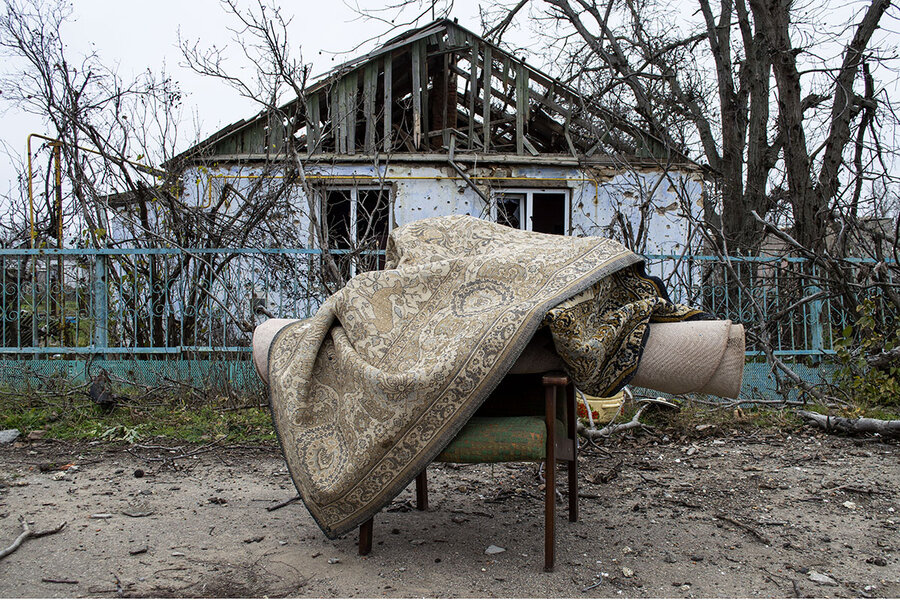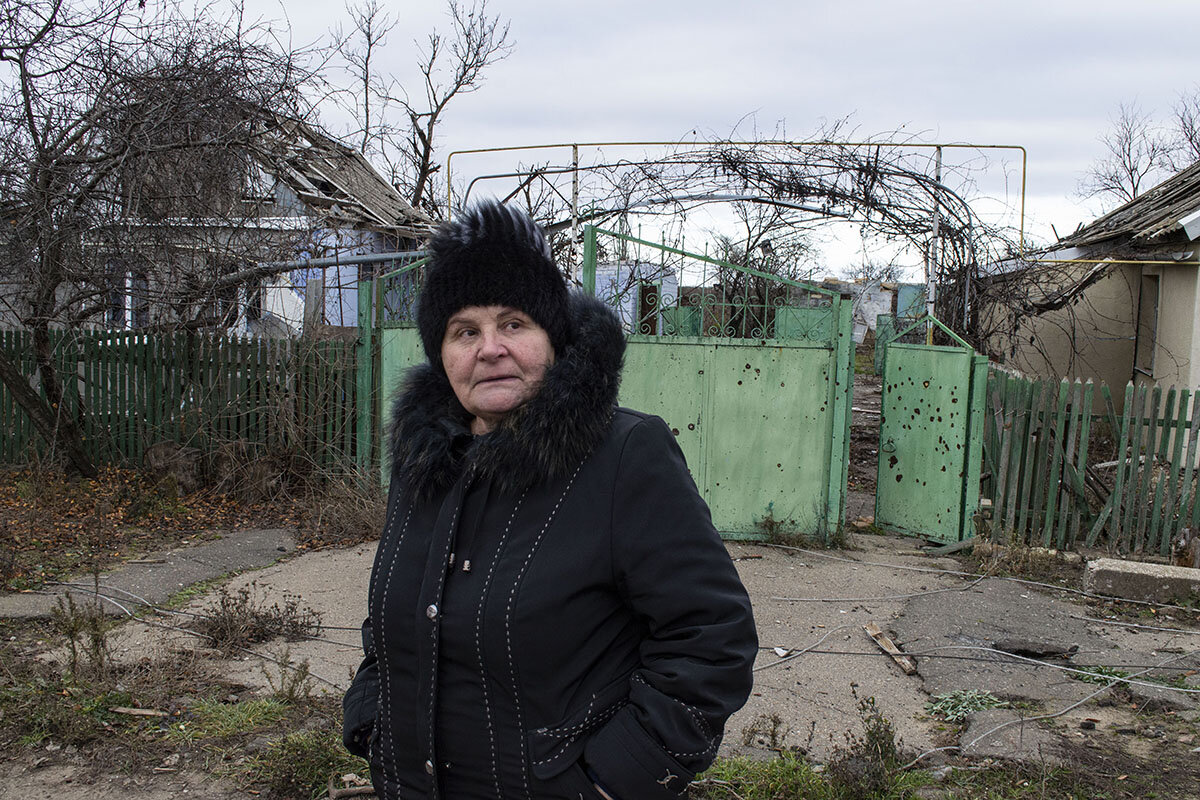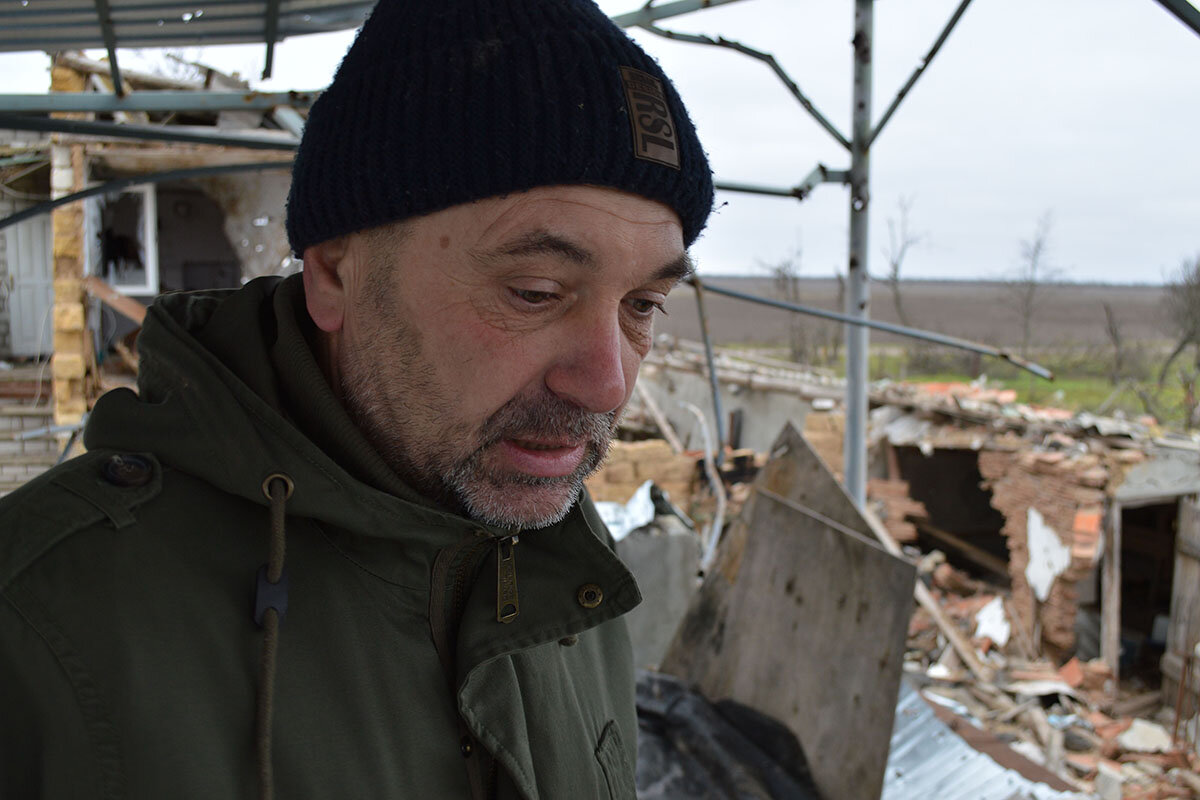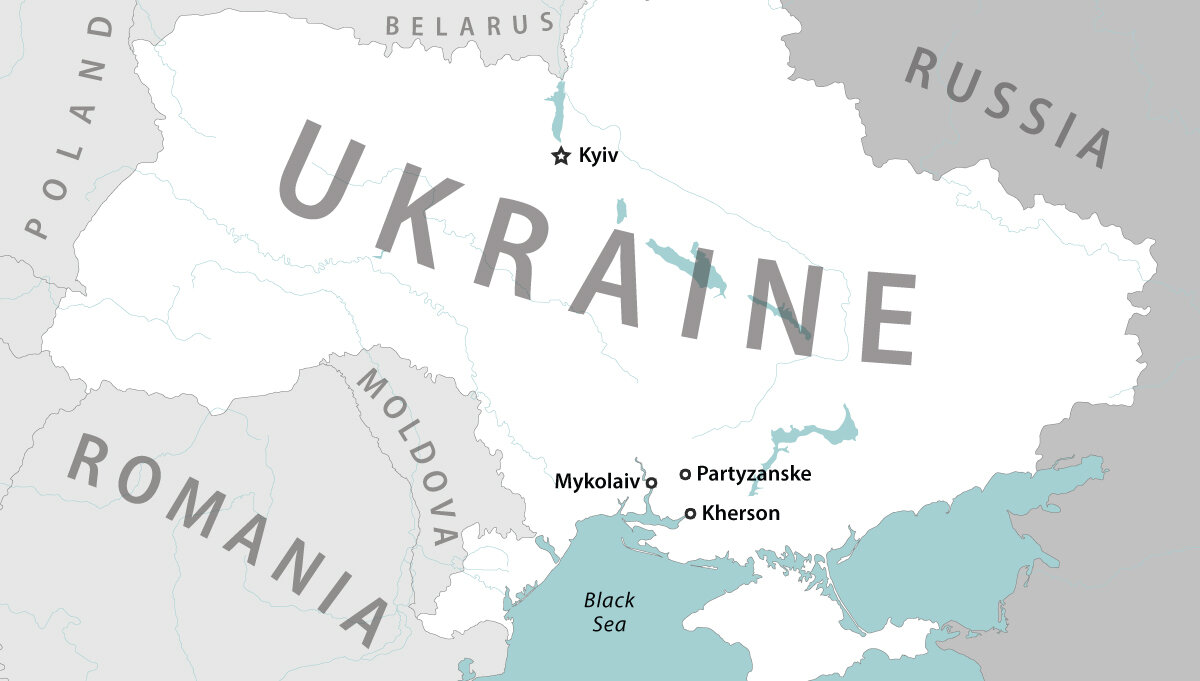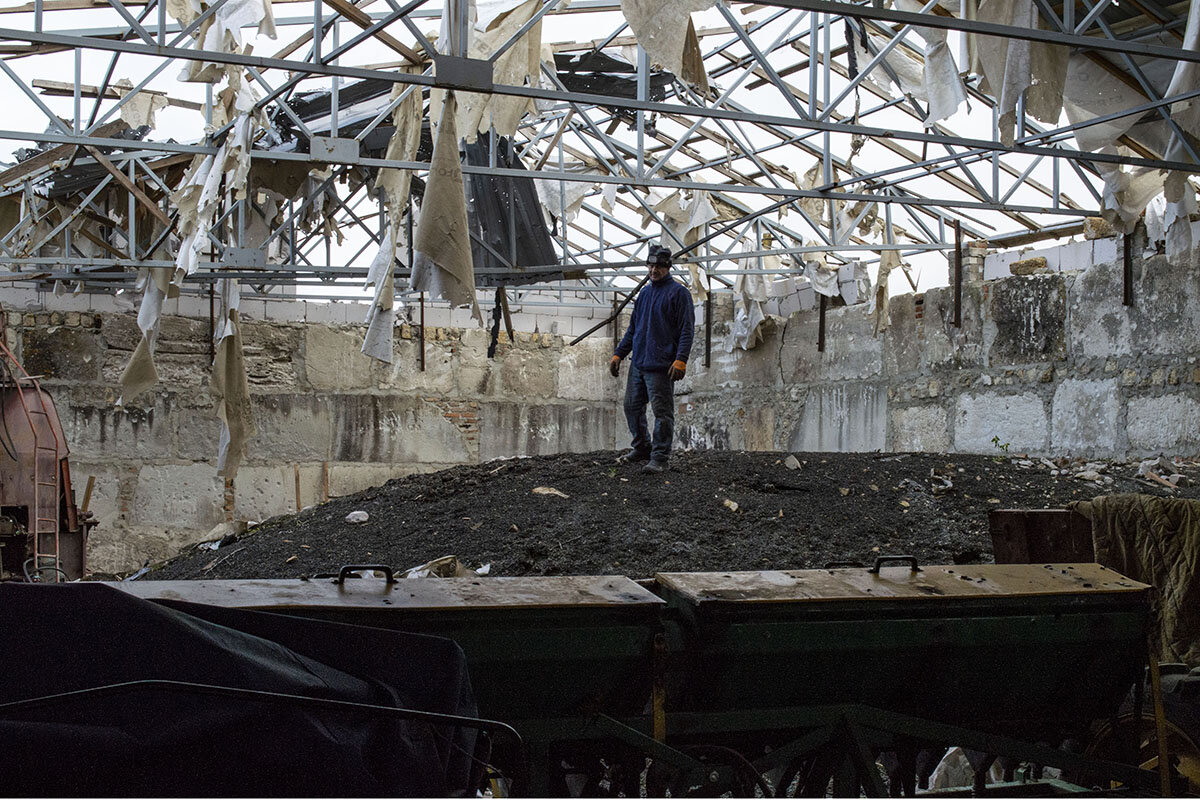Ukrainian villagers can go home now. Rebuilding is a different matter.
Loading...
| PARTYZANSKE, UKRAINE
For most people in this farming village, it was more than six months before they could come home, after Ukrainian officials had largely cleared away the mines in early December.
They had to take a bumpy dirt path to get here, because multiple bridges on the former route were damaged by shelling. They brought blankets, coats, tarps, tools, and food because their work would be long and the winter is harsh. They began repairing their homes, often without knowing where to start, and mourning with their neighbors.
The war had taken away what made Partyzanske, Partyzanske. Now, months after the Russian army retreated, the villagers are returning to again make their home a home.
Why We Wrote This
A story focused onAmid the war in Ukraine, villages like Partyzanske are the lowest priority for government rebuilding efforts. But residents are still going back to their war-torn homes to pull their lives back together.
“We are such fools that we will rebuild it,” says village leader Raisha Shulga.
The scenes in Partyzanske are a window into life as the Ukrainian government’s lowest priority. Fighting an all-consuming war and facing an economic recession, Kyiv can’t afford to rebuild everywhere. And what aid does exist mostly filters toward more densely populated cities like nearby Mykolaiv, where most of Partyzanske’s residents now live.
The humanitarian challenge for Ukraine’s government is that many of them don’t plan to stay in Mykolaiv. Making Partyzanske livable again will take months at the least, but villagers may not have a choice. Some are now renting apartments from people who themselves fled farther west and will eventually want their homes back. Others have lived in Partyzanske for decades and say it will always be their home, even if now there’s no home left.
“What about how you feel inside?” says Ms. Shulga. “You’re Ukrainian. You want to work your land.”
“We really wanted it to be beautiful”
Nataliia Shulgina and her son are cleaning the mess off their lawn when Ms. Shulga arrives. On the grass are cracked shingles, fence posts, plastic waste, broken bricks, and a heap of other rubble. Almost all that’s left of their roof is scaffolding. There’s a cluster bomb canister in the backyard – a souvenir of either the Russian capture of Partyzanske early in the war, or the Ukrainian army’s long defensive position here later.
They walk to the street, watching their feet because there are still some unexploded shells around, and hug Ms. Shulga. Together, they tour Ms. Shulgina’s home and point out vacant walls that used to be rooms.
Ms. Shulgina and her then-husband spent almost half of the 1990s building this home. There were carefully molded ceilings, a silo and water tower for their cows, and flowers decorated onto the outside walls. “We were working our whole life to build this house to leave it for our children and grandchildren,” she says. “We really wanted it to be beautiful.”
And for the first month of the war, she and her son stayed. They watched as the Russians overtook the area and retreated. They felt the shelling that began afterward – 42 explosions on March 31 alone. Soon after, they fled. There wasn’t anything left for their cows, so they let the animals go.
In Mykolaiv they rented an apartment, and her son found a job. The two of them now survive on that salary and occasional food aid. They came back in mid-November and found family photo albums and documents stored in a safe place by the Ukrainian soldiers who sheltered in their cellar. Their home’s religious icons were among the only things untouched, says Ms. Shulgina.
She and her son started clearing rubble and sorting the furniture that could be salvaged. “After that, the scale of work is so big we don’t even know what to start with,” she says. They can stay in Mykolaiv, even though rent is increasing.
“I feel pain in my heart because I like this life,” she says of the village. “You don’t have anything that is your own in the city.”
“A kind of captain, commander woman”
Ms. Shulga is used to organizing people.
Two years ago, she was chosen to head Partyzanske and a neighboring village for a five-year term. She earned the position because she’d lived in the area for 30 years and because of her chutzpah. “I’m a kind of captain, commander woman,” she says. “Everyone is like a friend of mine. I am like a mother to them.”
Before the war, there were 1,100 residents between the two villages. Just dozens of families have returned. Those who have did in part due to Ms. Shulga’s efforts to get Ukrainian deminers into the village. They’re still working around Partyzanske, detonating shells out of sight but within earshot.
The deminers first arrived in Partyzanske around early December, after two straight weeks of Ms. Shulga lobbying the local government, representing 11 villages. And she urged residents to return because the deminers can only enter private property with the owner’s consent, and homes might otherwise be ignored.
But almost none of the returned families actually live in the village, which creates something of a bureaucratic paradox. The local government won’t buy simple supplies like tarps for people unless they live full time in a damaged home, says Ms. Shulga. But to actually return full time to their damaged homes, the people of Partyzanske need far more than tarps.
Supplies often just aren’t available, says Oleksandr Tolokinnikov, chief of press service for the neighboring Kherson Regional Military Administration, whose villages face similar rebuilding needs. The government has been distributing wood stoves and other heating equipment for villages this winter, he says. Even with aid programs, crucial materials are still scarce.
“Not many people want to risk their lives and go there to work to rebuild,” says Mr. Tolokinnikov. “There is the need and there are the programs to help them, but there is also a lack of resources.”
Even villages with less damage than Partyzanske suffer from being low priorities. Farmers need to harvest their crops in order to plant this spring, but fields are the last areas that will be demined in the region. Meanwhile, missile tails and cluster bomb canisters poke out of fields like lawn darts.
“Now we have to work even more”
Mr. Tolokinnikov says the government is just telling people to stay away from such fields.
For villages like Partyzanske, that’s almost like saying they can’t restart their lives. People live off the land.
Before the war, Oleksander Zveryshyn and his wife, Hanne, farmed thousands of acres in the area. When Ms. Shulga walks to their home, though, the yard is filled with scorched vehicles and debris. Inside his barn, Mr. Zveryshyn stands atop a mountain of sunflower seeds, illuminated by light through an empty roof. Torn plastic hangs from the rafters like drapes.
Since mid-November, he and his wife have regularly driven to the village and worked from 7 in the morning to 7 at night. Their 180 tons of seeds are all ruined here, he says – fresh and black on the surface but arid and gray underneath. Their tractors, aerators, and harvesters are almost all damaged. Mr. Zveryshyn hopes to lease another farmer’s in the spring.
If he could get reasonable loans somewhere, the farm could be back to normal in two years, he guesses. But those are hard to find, he says, and they can’t count on the government.
“We were hard workers and now we have to work even more,” says Mr. Zveryshyn.
Ms. Shulga walks into another building next door to have coffee with her husband, Serhii. There’s a carpet hanging over the door, keeping heat from a wood stove in the room.
For years, she and Serhii put off renovating their own home because of other expenses – children, tuition, weddings, apartments. But “at some point, we decided to do something for ourselves,” she says. They finished three years ago, having added panoramic windows and a brick driveway. “We didn’t have enough time to enjoy the luxury life that we had,” says Ms. Shulga.
Their home is on the village line and was under direct Russian fire. Shells punched through their walls and ruined their farming equipment. In early December, they were planning to buy a mobile home in Kyiv and move into their driveway.
Ms. Shulga describes her old home as though she were telling stories of a lost friend. In the winter, she says, the village is almost always under a harsh, cold wind, but their home was sealed.
“It was very cozy,” she says, pausing. “It will be as well.”
Oleksandr Naselenko supported the reporting of this article.




